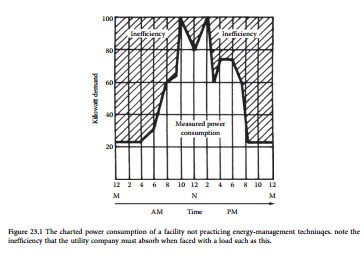Peak Demand
Conserving energy is a big part of the power bill reduction equation, but it is not the whole story. The peak demand of the customer load is an important criterion in the utility company’s calculation of rate structures. The peak demand figure is a measure of the maximum load placed on the utility company sys- tem by a customer during a predetermined billing cycle. The measured quantities may be kilowatts, kilo- volt-amperes, or both. Time intervals used for this measurement range from 15 to 60 min. Billing cycles may be annual or semiannual. Figure 23.1 shows an example of varying peak demand.
If a facility operated at basically the same power consumption level from one hour to the next and one day to the next, the utility company could predict accurately the demand of the load, and then size its equipment (including the allocation of energy reserves) for only the amount of power actually needed. For the example shown in the figure, however, the utility company must size its equipment (including allocated energy reserves) for the peak demand. The area between the peak demand and the actual usage is the margin of inefficiency that the customer forces upon the utility. The peak demand factor is a method used by utility companies to assess penalties for such operation, thereby encouraging the customer to approach a more efficient state of operation (from the utility’s viewpoint).
Load shedding is a term used to describe the practice of trimming peak power demand to reduce high-demand penalties. The goal of load shedding is to schedule the operation of nonessential equipment so as to provide a uniform power load to the utility company and, thereby, a better kWh rate. Nearly any operation has certain electric loads that can be rescheduled on a permanent basis or deferred as power demand increases during the day. Figure 23.2 illustrates the results of a load-shedding program. This more efficient operation has a lower overall peak demand and a higher average demand.
Peak demand reduction efforts can cover a wide range of possibilities. It would be unwise from an energy standpoint, for example, to test high-power standby equipment on a summer afternoon, when air-conditioning units may be in full operation. Morning or evening hours would be a better choice, when the air-conditioning is off and the demand of office equipment is reduced. Each operation is unique and requires an individual assessment of load-shedding options.
An automated power-demand controller provides an effective method of managing peak demand. A controller can analyze the options available and switch loads as needed to maintain a relatively constant power demand from the utility company. Such systems are programmed to recognize which loads have priority and which loads are nonessential. Power demand then is automatically adjusted by the system, based upon the rate schedule of the utility company. Many computerized demand control systems also provide the customer a printout of the demand profile of the plant, further helping managers analyze and reduce power costs. Figure 23.3 shows one such printout. Note that both energy demand and the costs for that energy are provided.

